Petra (Arabic: ٱلْبَتْراء, romanized: Al-Batrāʾ; Greek: Πέτρα, "Rock"), originally known to its inhabitants as Raqmu or Raqēmō (Nabataean: 𐢛𐢚𐢒 or 𐢛𐢚𐢓𐢈, *Raqēmō), is a historic and archaeological city in southern Jordan. Famous for its rock-cut architecture and water conduit system, Petra is also called the "Rose City" because of the colour of the sandstone from which it is carved; it was famously called "a rose-red city half as old as time" in a poem of 1845 by John Burgon. It is adjacent to the mountain of Jabal Al-Madbah, in a basin surrounded ...Read more
Petra (Arabic: ٱلْبَتْراء, romanized: Al-Batrāʾ; Greek: Πέτρα, "Rock"), originally known to its inhabitants as Raqmu or Raqēmō (Nabataean: 𐢛𐢚𐢒 or 𐢛𐢚𐢓𐢈, *Raqēmō), is a historic and archaeological city in southern Jordan. Famous for its rock-cut architecture and water conduit system, Petra is also called the "Rose City" because of the colour of the sandstone from which it is carved; it was famously called "a rose-red city half as old as time" in a poem of 1845 by John Burgon. It is adjacent to the mountain of Jabal Al-Madbah, in a basin surrounded by mountains forming the eastern flank of the Arabah valley running from the Dead Sea to the Gulf of Aqaba. Access to the city is through a famously picturesque 1.2-kilometre-long (3⁄4 mi) gorge called the Siq, which leads directly to the Khazneh.
The area around Petra has been inhabited from as early as 7000 BC, and the Nabataeans might have settled in what would become the capital city of their kingdom as early as the 4th century BC. Archaeological work has only discovered evidence of Nabataean presence dating back to the second century BC, by which time Petra had become their capital. The Nabataeans were nomadic Arabs who invested in Petra's proximity to the incense trade routes by establishing it as a major regional trading hub.
The trading business gained the Nabataeans considerable revenue and Petra became the focus of their wealth. Unlike their enemies, the Nabataeans were accustomed to living in the barren deserts and were able to repel attacks by taking advantage of the area's mountainous terrain. They were particularly skillful in harvesting rainwater, agriculture, and stone carving. Petra flourished in the 1st century AD, when its Al-Khazneh structure, possibly the mausoleum of Nabataean king Aretas IV, was constructed, and its population peaked at an estimated 20,000 inhabitants. They developed a complex system of cisterns, channels, and dams to collect and store rainwater, allowing them to thrive in the arid desert environment. Most of the famous rock-cut buildings, which are mainly tombs, date from this and the following period. Much less remains of the free-standing buildings of the city.
Although the Nabataean kingdom became a client state of the Roman Empire in the first century BC, it was only in 106 AD that it lost its independence. Petra fell to the Romans, who annexed Nabataea and renamed it as Arabia Petraea. Petra's importance declined as sea trade routes emerged, and after an earthquake in 363 destroyed many structures. In the Byzantine era, several Christian churches were built, but the city continued to decline and, by the early Islamic era, it was abandoned except for a handful of nomads. It remained unknown to the western world until 1812, when Swiss traveller Johann Ludwig Burckhardt rediscovered it.
It has been a UNESCO World Heritage Site since 1985. UNESCO has described Petra as "one of the most precious cultural properties of man's cultural heritage". In 2007, Petra was voted one of the New 7 Wonders of the World. Petra is a symbol of Jordan, as well as Jordan's most-visited tourist attraction. Tourist numbers peaked at 1.1 million in 2019, marking the first time that the figure rose above the 1 million mark. Tourism in the historical city was hit hard by the COVID-19 pandemic, but soon after started to pick up again, reaching 905,000 visitors in 2022.
By 7000 BC, some of the earliest recorded farmers had settled in Beidha, a Pre-Pottery Neolithic settlement just north of Petra.[1]
Bronze AgePetra is listed in Egyptian campaign accounts and the Amarna letters as Pel, Sela, or Seir.[2]
Iron Age EdomThe Iron Age lasted between 1200 and 600 BC; in that time, the Petra area was occupied by the Edomites. The configuration of mountains in Petra allowed for a reservoir of water for the Edomites. This made Petra a stopping ground for merchants, making it an outstanding area for trade. Things that were traded here included wines, olive oil, and wood.
Initially, the Edomites were accompanied by Nomads who eventually left, but the Edomites stayed and made their mark on Petra before the emergence of the Nabataens. It is said that 10,000 men were thrown off of the mountain Umm el-Biyara, but this story has been debated by scholars.[3]
The Edomite site excavated at the top of the Umm el-Biyara mountain at Petra was established no earlier than the seventh century BC (Iron II).[4]
Emergence of PetraThe Nabataeans were one among several nomadic Bedouin tribes that roamed the Arabian Desert and moved with their herds to wherever they could find pasture and water.[5] Although the Nabataeans were initially embedded in Aramaic culture, theories about them having Aramean roots are rejected by many modern scholars. Instead, archaeological, religious and linguistic evidence confirm that they are a northern Arabian tribe.[6] Current evidence suggests that the Nabataean name for Petra was Raqēmō, variously spelled in inscriptions as rqmw or rqm.[7]
The Jewish historian Josephus (ca. 37–100 AD) writes that the region was inhabited by the Midianites during the time of Moses, and that they were ruled by five kings, one of whom was Rekem. Josephus mentions that the city, called Petra by the Greeks, "ranks highest in the land of the Arabs" and was still called Rekeme by all the Arabs of his time, after its royal founder (Antiquities iv. 7, 1; 4, 7).[8] The Onomasticon of Eusebius also identified Rekem as Petra.[9] Arabic raqama means "to mark, to decorate", so Rekeme could be a Nabataean word referring to the famous carved rock façades. In 1964, workmen clearing rubble away from the cliff at the entrance to the gorge found several funerary inscriptions in Nabatean script. One of them was to a certain Petraios who was born in Raqmu (Rekem) and buried in Garshu (Jerash).[10][11]
An old theory held that Petra might be identified with a place called sela in the Hebrew Bible. Encyclopædia Britannica (1911) states that the Semitic name of the city, if not Sela, would remain unknown. It nevertheless cautioned that sela simply means "rock" in Hebrew, and thence might not be identified with a city where it occurs in the biblical text in the book of Obadiah. It is possible that the city was part of the nation of Edom. [12]
The passage in Diodorus Siculus (xix. 94–97) which describes the expeditions which Antigonus sent against the Nabataeans in 312 BC, was understood by some researchers to throw some light upon the history of Petra, but the "petra" (Greek for rock) referred to as a natural fortress and place of refuge cannot be a proper name, and the description implies that there was no town in existence there at the time.[12][13]
Roman period General view
General view Roman bronze coin of Geta showing the Petra temple with statue of Tyche
Roman bronze coin of Geta showing the Petra temple with statue of Tyche
In AD 106, when Cornelius Palma was governor of Syria, the part of Arabia under the rule of Petra was absorbed into the Roman Empire as part of Arabia Petraea, and Petra became its capital.[14] The native dynasty came to an end but the city continued to flourish under Roman rule. It was around this time that the Petra Roman Road was built. A century later, in the time of Alexander Severus, when the city was at the height of its splendor, the issue of coinage came to an end. There was no more building of sumptuous tombs, owing apparently to some sudden catastrophe, such as an invasion by the neo-Persian power under the Sassanid Empire.[12]
Meanwhile, as Palmyra (fl. 130–270) grew in importance and attracted the Arabian trade away from Petra, the latter declined. It appears, however, to have lingered on as a religious center. Another Roman road was constructed at the site. Epiphanius of Salamis (c.315–403) writes that in his time a feast was held there on December 25 in honor of the virgin Khaabou (Chaabou) and her offspring Dushara.[12] Dushara and al-Uzza were two of the main deities of the city, which otherwise included many idols from other Nabataean deities such as Allat and Manat.[15]
Between 111 and 114 Trajan built the Via Traiana Nova, running from the Syrian border to the Red Sea through Petra. This road followed the old routes of Nabataean caravans. In the shadow of the Pax Romana, this route revived trade between Arabia, Syria, and Mediterranean harbors. In 125 AD, one of Emperor Hadrian's administrators left marks[dubious ] in Petra, pointed out by documents found at the Dead Sea. In 130 AD, Hadrian visited the former Nabataean capital, giving it the name of Hadriānī Petra Metropolis, imprinted on his coins. His visit, however, did not lead to any boom in development and new buildings as it did in Jerash. The province's governor, Sextius Florentinus, erected a monumental mausoleum for his son near the end of the al-Hubta (King's Wall) tombs, which had been generally reserved during the Nabataean period for the royal family.
The interest that Roman emperors showed in the city in the 3rd century suggests that Petra and its environs remained highly esteemed for a long time. An inscription to Liber Pater, a god revered by Emperor Septimius Severus, was found in the temenos of the temple known as Qasr al-Bint, and Nabataean tombs contained silver coins with the emperor's portrait, as well as pottery from his reign. Emperor Elagabalus declared Petra to be a Roman colony, when he reorganized the Roman Empire towards the end of the 3rd century.[16] The area from Petra to Wadi Mujib, the Negev, and the Sinai Peninsula were annexed into the province of Palaestina Salutaris. Petra may be seen on the Madaba mosaic map from the reign of Emperor Justinian.
Byzantine period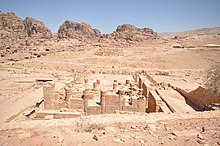 The Byzantine Church
The Byzantine ChurchPetra declined rapidly under Roman rule, in large part from the revision of sea-based trade routes. In 363, an earthquake destroyed many buildings and crippled the vital water management system.[17] The old city of Petra was the capital of the Byzantine province of Palaestina III and many churches from the Byzantine period were excavated in and around Petra. In one of them, the Byzantine Church, 140 papyri were discovered, which contained mainly contracts dated from 530s to 590s, establishing that the city was still flourishing in the 6th century.[18] The Byzantine Church is a prime example of monumental architecture in Byzantine Petra.
The last reference to Byzantine Petra comes from the Spiritual Meadow of John Moschus, written in the first decades of the 7th century. He gives an anecdote about its bishop, Athenogenes. It ceased to be a metropolitan bishopric sometime before 687 when that function had been transferred to Areopolis. Petra is not mentioned in the narratives of the Muslim conquest of the Levant, nor does it appear in any early Islamic records.[19]
Crusaders and Mamluks Alwaeira Castle
Alwaeira CastleIn the 12th century, the Crusaders built fortresses such as the Alwaeira Castle, but were forced to abandon Petra after a while. As a result, the location of Petra was lost until the 19th century.[20][21]
Two further Crusader-period castles are known in and around Petra: the first is al-Wu'ayra, situated just north of Wadi Musa. It can be viewed from the road to Little Petra. It is the castle that was seized by a band of Turks with the help of local Muslims and only recovered by the Crusaders after they began to destroy the olive trees of Wadi Musa. The potential loss of livelihood led the locals to negotiate a surrender. The second is on the summit of el-Habis, in the heart of Petra, and can be accessed from the West side of the Qasr al-Bint.
The ruins of Petra were an object of curiosity during the Middle Ages and were visited by Baibars, one of the first Mamluk sultans of Egypt, towards the end of the 13th century.[12]
19th and 20th centuries Petra Siq in 1947 (left) compared with the same location in 2013
Petra Siq in 1947 (left) compared with the same location in 2013The first European to describe them was the Swiss traveler Johann Ludwig Burckhardt during his travels in 1812.[12][22] At that time, the Greek Orthodox Patriarchate of Jerusalem operated a diocese in al-Karak named Battra (Arabic: باطره, Ancient Greek: Πέτρας) and it was the opinion among the clergy of Jerusalem that Kerak was the ancient city of Petra.[22]
Burckhardt already spoke Arabic fluently, and was on his way to explore the Niger River when he heard stories of a dead city that held the tomb of the Prophet Aaron, and became fascinated with finding the city. He then dressed himself up as a local, and only spoke in Arabic, bringing a goat with him with the intent of sacrificing it in honor of Aaron's Tomb. After one day of exploring, he was convinced that he had found the lost city of Petra.[23]
Léon de Laborde and Louis-Maurice-Adolphe Linant de Bellefonds made the first accurate drawings of Petra in 1828.[24] The Scottish painter David Roberts visited Petra in 1839 and returned to Britain with sketches and stories of the encounter with local tribes, published in The Holy Land, Syria, Idumea, Arabia, Egypt, and Nubia. Frederic Edwin Church, the leading American landscape painter of the 19th century, visited Petra in 1868, and the resulting painting El Khasné, Petra is among his most important and well-documented.[24] Missionary Archibald Forder published photographs of Petra in the December 1909 issue of National Geographic.
 the "Street of Facades"
the "Street of Facades"Because the structures weakened with age, many of the tombs became vulnerable to thieves, and many treasures were stolen. In 1929, a four-person team consisting of British archaeologists Agnes Conway and George Horsfield, Palestinian physician and folklore expert Tawfiq Canaan and Ditlef Nielsen, a Danish scholar, excavated and surveyed Petra.[25]
The archaeologist Philip Hammond from the University of Utah visited Petra for nearly 40 years. He explained that the local folklore says it was created by the wand of Moses, when he struck the rock to bring forth water for the Israelites. Hammond believed the carved channels deep within the walls and ground were made from ceramic pipes that once fed water for the city, from rock-cut systems on the canyon rim.[26]
In the 1980s, the Bedul Bedouin, once inhabitants of Petra, were relocated by the Jordanian government to the nearby settlement of Umm Sayhoun, a process spanning two decades. This move was part of broader initiatives aimed at settling Bedouin communities and promoting tourism in Petra.[27][28] With a name meaning "the changing ones" and oral traditions recounting a conversion narrative, the Bedul Bedouins are believed to have adopted Islam later in their history, possibly with Jewish or Nabatean origins.[29][30][31] Today, alongside their traditional activities, they engage in local tourism, alongside the more prominent Liyathnah tribe.[27]
Numerous scrolls in Greek and dating to the Byzantine period were discovered in an excavated church near the Temple of the Winged Lions in Petra in December 1993.[32]
21st centuryIn December 2022, Petra was hit by heavy flooding.[33]
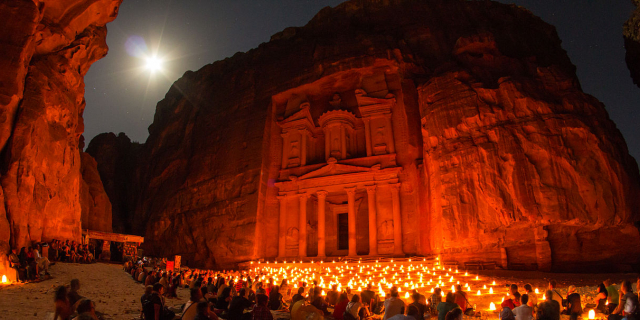












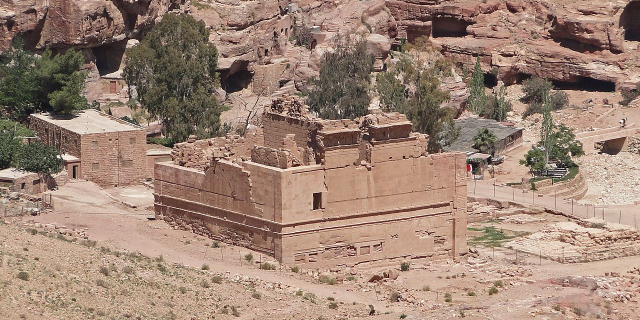
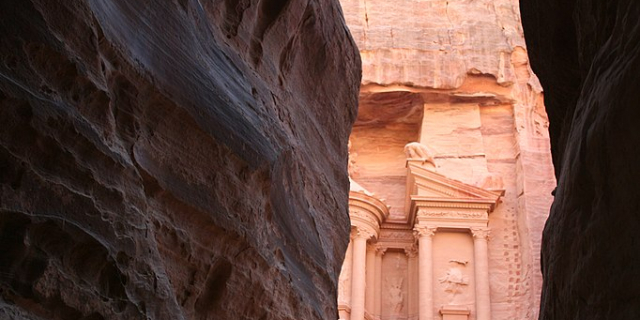
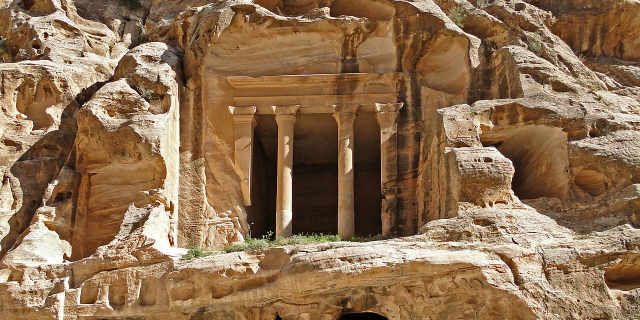











Add new comment